Microstructure and Mechanical Property of 6082 Aluminum Alloy via Sc and Zr Addition Combined with Squeeze Casting
Abstract
:1. Introduction
2. Materials and Methods
2.1. Materials Fabrication
2.2. Material Characterizations
2.3. Mechanical Testing
3. Results and Discussion
3.1. As-Cast Microstructure and Properties of 6082 Alloy and Sc-Zr-6082
3.2. Mechanical Properties of the Alloy After Heat Treatment
3.3. Mechanical Properties of Aluminum Alloy Components
4. Conclusions
Author Contributions
Funding
Institutional Review Board Statement
Informed Consent Statement
Data Availability Statement
Conflicts of Interest
References
- Yang, T.; Xing, C.; Li, X.Y. Evaluation and analysis of new-energy vehicle industry policies in the context of technical innovation in China. J. Clean. Prod. 2021, 281, 125126. [Google Scholar] [CrossRef]
- Zhang, X.W.; Yang, Y.; Jin, H.N.; Sui, Y.D.; Jiang, Y.H.; Wang, Q.D. Effect of lanthanum content on microstructure and mechanical properties of Al–5Mg–2Si-0.6Mn alloy in squeeze casting. J. Mater. Res. Technol. 2021, 15, 6025–6033. [Google Scholar] [CrossRef]
- Arowosola, A.; Gaustad, G. Estimating increasing diversity and dissipative loss of critical metals in the aluminum automotive sector. Resour. Conserv. Recycl. 2019, 150, 104382. [Google Scholar] [CrossRef]
- Xiao, P.J.; Xu, S.W.; Chen, L.B.; Liu, Y.; Li, J.Y.; Xiao, Z.; Meng, X.M. Effect of casting process and thermal exposure on microstructure and mechanical properties of Al-Si-Cu-Ni alloy. Metals 2024, 17, 4598. [Google Scholar] [CrossRef] [PubMed]
- Chen, H.P.; Wu, S.S.; Li, J.Y.; Zhao, D.J.; Lü, S.L. Effects of low nickel content on microstructure and high-temperature mechanical properties of Al-7Si-1.5Cu-0.4Mg aluminum alloy. Metals 2024, 14, 223. [Google Scholar] [CrossRef]
- Shaha, S.K.; Czerwinski, F.; Kasprzak, W.; Friedman, J.; Chen, D.L. Monotonic and cyclic deformation behavior of the Al–Si–Cu–Mg cast alloy with micro-additions of Ti, V and Zr. Int. J. Fatigue 2015, 70, 383–394. [Google Scholar] [CrossRef]
- Birol, Y.; Ilgaz, O. Effect of cast and extruded stock on grain structure of EN AW 6082 alloy forgings. Mater. Sci. Technol. 2014, 30, 860–866. [Google Scholar] [CrossRef]
- Chang, X.S.; Chen, C.; Sun, W.; Zhang, H.M.; Chu, G.N.; Zhang, X.; Han, F.; Zhang, W.C.; Du, Z.M. Microstructures, mechanical properties and solidification mechanism of a hot tearing sensitive aluminum alloy asymmetric part fabricated by squeeze casting. J. Alloys Compd. 2021, 886, 161254. [Google Scholar] [CrossRef]
- Jiang, J.F.; Yan, J.; Liu, Y.Z.; Hu, G.Q.; Wang, Y.; Ding, C.J.; Zou, D.C. Investigation on heat treatment of large-sized and complex AlSi9Mg aluminum alloy components formed by squeeze casting. J. Alloys Compd. 2022, 924, 166504. [Google Scholar] [CrossRef]
- Han, G.M.; Han, Z.Q.; Luo, A.A.; Liu, B.C. Microstructure characteristics and effect of aging process on the mechanical properties of squeeze-cast AZ91 alloy. J. Alloys Compd. 2015, 641, 56–63. [Google Scholar] [CrossRef]
- Edosa, O.O.; Tekweme, F.K.; Gupta, K.P. Squeeze casting for metal alloys and composites: An overview of influence of process parameters on mechanical properties and microstructure. China Foundry 2023, 20, 148–158. [Google Scholar] [CrossRef]
- Yang, L.J. The effect of solidification time in squeeze casting of aluminium and zinc alloys. J. Mater. Process. Technol. 2007, 192, 114–120. [Google Scholar] [CrossRef]
- He, J.J.; Jia, Q.; Wang, X.Q.; Cao, X.M.; Ding, Z.C.; Cao, Z.Q.; Gu, X.F. Transformation microstructure and nucleation crystallography in high Sc-contained Al–Sc alloys after laser treatment. J. Mater. Sci. 2024, 59, 7075–7088. [Google Scholar] [CrossRef]
- Jin, H.N.; Sui, Y.D.; Yang, Y.; Jiang, Y.H.; Wang, Q.D. Effect of Ce content on the microstructure and mechanical properties of squeeze-cast Al–5Mg-2.2Si-0.6Mn alloys. J. Mater. Res. Technol. 2022, 19, 1798–1804. [Google Scholar] [CrossRef]
- Hu, G.; Zhu, C.; Xu, D.; Dong, P.X.; Chen, K.H. Effect of cerium on microstructure, mechanical properties and corrosion properties of Al-Zn-Mg alloy. J. Rare Earths 2021, 39, 208–216. [Google Scholar] [CrossRef]
- He, Y.; Xi, H.H.; Ming, W.Q.; Shao, Q.Q.; Shen, R.H.; Lai, Y.X.; Wu, C.L.; Chen, J.H. Thermal stability and precipitate microstructures of Al−Si−Mg−Er alloy. Trans. Nonferrous Met. Soc. China 2021, 31, 1–10. [Google Scholar] [CrossRef]
- Xu, C.; Xiao, W.L.; Zheng, R.X.; Hanada, S.J.; Yamagata, H.; Ma, C.L. The synergic effects of Sc and Zr on the microstructure and mechanical properties of Al–Si–Mg alloy. Mater. Des. 2015, 88, 485–492. [Google Scholar] [CrossRef]
- Yi, H.; Ren, K.; Chen, H.; Cheng, X.; Xie, X.; Liang, M.; Yin, B.; Yang, Y. Molten aluminum-induced corrosion and wear-resistance properties of ZrB2-based cermets improved by sintering-temperature manipulation. Materials 2024, 17, 4451. [Google Scholar] [CrossRef]
- Trudonoshyn, O.; Prach, O.; Randelzhofer, P.; Durst, K.; Körner, C. Heat treatment of the new high-strength high-ductility Al–Mg–Si–Mn alloys with Sc, Zr and Cr additions. Materials 2021, 15, 100981. [Google Scholar] [CrossRef]
- Feng, J.; Ye, B.; Zuo, L.J.; Qi, R.J.; Wang, Q.D.; Jiang, H.Y.; Huang, R.; Ding, W.J.; Yao, J.; Wang, C. Effects of Zr, Ti and Sc additions on the microstructure and mechanical properties of Al-0.4Cu-0.14Si-0.05Mg-0.2Fe alloys. J. Mater. Sci. Technol. 2018, 34, 2316–2324. [Google Scholar] [CrossRef]
- Leng, J.F.; Ren, B.H.; Zhou, Q.B.; Zhao, J.W. Effect of Sc and Zr on recrystallization behavior of 7075 aluminum alloy. Trans. Nonferrous Met. Soc. China 2021, 31, 2545–2557. [Google Scholar] [CrossRef]
- Deng, Y.; Yin, Z.M.; Zhao, K.; Duan, J.Q.; He, Z.B. Effects of Sc and Zr microalloying additions on the microstructure and mechanical properties of new Al–Zn–Mg alloys. J. Alloys Compd. 2012, 530, 71–80. [Google Scholar] [CrossRef]
- Chang, Y.L.; Hung, F.Y.; Lui, T.S. Study of microstructure and tensile properties of infrared-heat-treated cast-forged 6082 aluminum alloy. J. Mater. Res. Technol. 2019, 8, 173–179. [Google Scholar] [CrossRef]
- Zhu, J.; Jiang, W.; Li, G.Y.; Guan, F.; Yu, Y.; Fan, Z. Microstructure and mechanical properties of SiCnp/Al6082 aluminum matrix composites prepared by squeeze casting combined with stir casting. J. Mater. Process. Technol. 2020, 283, 116699. [Google Scholar] [CrossRef]
- Bordeasu, I.; Ghiban, B.; Micu, L.M.; Luca, A.N.; Demian, A.M.; Istrate, D. The influence of heat aging treatments on the cavitation erosion behavior of a type 6082 aluminum alloy. Materials 2023, 16, 5875. [Google Scholar] [CrossRef]
- Kasprzak, W.; Amirkhiz, B.S.; Niewczas, M. Structure and properties of cast Al–Si based alloy with Zr–V–Ti additions and its evaluation of high temperature performance. J. Alloys Compd. 2014, 595, 67–79. [Google Scholar] [CrossRef]
- Yu, M.; Zhu, B.; Li, N.; Zheng, H.Y.; Lu, Y.; Yu, X.P. Study on microstructure, tensile performance and creep resistance of Al–Mg–Si–Sc–Zr alloy strengthened by Al3(Sc, Zr) nanoprecipitates. Mater. Sci. Eng. A 2024, 897, 146362. [Google Scholar] [CrossRef]
- Liu, Y.; Lai, Y.X.; Chen, Z.Q.; Chen, S.L.; Gao, P.; Chen, J.H. Formation of β″-related composite precipitates in relation to enhanced thermal stability of Sc-alloyed Al-Mg-Si alloys. J. Alloys Compd. 2021, 885, 160942. [Google Scholar] [CrossRef]
- Elgallad, E.M.; Doty, H.W.; Alkahtani, S.A.; Samuel, F.H. Effects of La and Ce addition on the modification of Al-Si based alloys. Adv. Mater. Sci. Eng. 2016, 2016, 5027243. [Google Scholar] [CrossRef]
- Marodkar, A.S.; Patil, H.; Borkar, H.; Behl, A. Effect of squeeze casting and combined addition of calcium and strontium on microstructure and mechanical properties of AZ91 magnesium alloy. Int. J. Met. 2023, 17, 2252–2270. [Google Scholar] [CrossRef]
- Ji, S.X.; Yang, W.C.; Gao, F.; Watson, D.; Fan, Z.Y. Effect of iron on the microstructure and mechanical property of Al–Mg–Si–Mn and Al–Mg–Si diecast alloys. Mater. Sci. Eng. A 2013, 564, 130–139. [Google Scholar] [CrossRef]
- Kwon, E.P.; Woo, K.D.; Kim, S.H.; Kang, D.S.; Lee, K.J.; Jeon, J.Y. The effect of an addition of Sc and Zr on the precipitation behavior of AA6061 alloy. Met. Mater. Int. 2010, 16, 701–707. [Google Scholar] [CrossRef]
- Najafi, S.; Sabbaghian, M.; Sheikhani, A.; Nagy, P.; Fekete, K.; Gubicza, J. Effect of addition of rare earth elements on the microstructure, texture, and mechanical properties of extruded ZK60 alloy. Met. Mater. Int. 2023, 29, 1699–1711. [Google Scholar] [CrossRef]
- Huang, T.L.; Shuai, L.F.; Wakeel, A.; Wu, G.; Hansen, N.; Huang, X. Strengthening mechanisms and Hall-Petch stress of ultrafine grained Al-0.3%Cu. Acta Mater. 2018, 156, 369–378. [Google Scholar] [CrossRef]
- Xu, X.H.; Zhu, W.B.; Guo, X.B.; Liang, C.J.; Deng, Y.L. Effect of ageing treatment process on the microstructure development and mechanical properties of 6082 Al alloy. J. Alloys Compd. 2023, 935, 167892. [Google Scholar] [CrossRef]
- Sai Ganesh, M.R.; Reghunath, N.; Levin, M.J.; Prasad, A.; Doondi, S.; Shankar, K.V. Strontium in Al–Si–Mg alloy: A review. Met. Mater. Int. 2022, 28, 1–40. [Google Scholar] [CrossRef]
- Liu, L.; Jiang, J.T.; Cui, X.Y.; Zhang, B.; Zhen, L. Correlation between precipitates evolution and mechanical properties of Al-Sc-Zr alloy with Er additions. J. Mater. Sci. Technol. 2022, 99, 61–72. [Google Scholar] [CrossRef]
- Wang, W.Y.; Pan, Q.L.; Lin, G.; Wang, X.P.; Sun, Y.Q.; Wang, X.D.; Ye, J.; Sun, Y.W.; Yu, Y.; Jiang, F.Q.; et al. Microstructure and properties of novel Al-Ce-Sc, Al-Ce-Y, Al-Ce-Zr and Al-Ce-Sc-Y alloy conductors processed by die casting, hot extrusion and cold drawing. J. Mater. Sci. Technol. 2020, 58, 155–170. [Google Scholar] [CrossRef]
- Zhao, B.W.; Yang, Q.; Wu, L.; Li, X.F.; Wang, M.L.; Wang, H.W. Effects of nanosized particles on microstructure and mechanical properties of an aged in-situ TiB2/Al-Cu-Li composite. Mater. Sci. Eng. A 2019, 742, 573–583. [Google Scholar] [CrossRef]
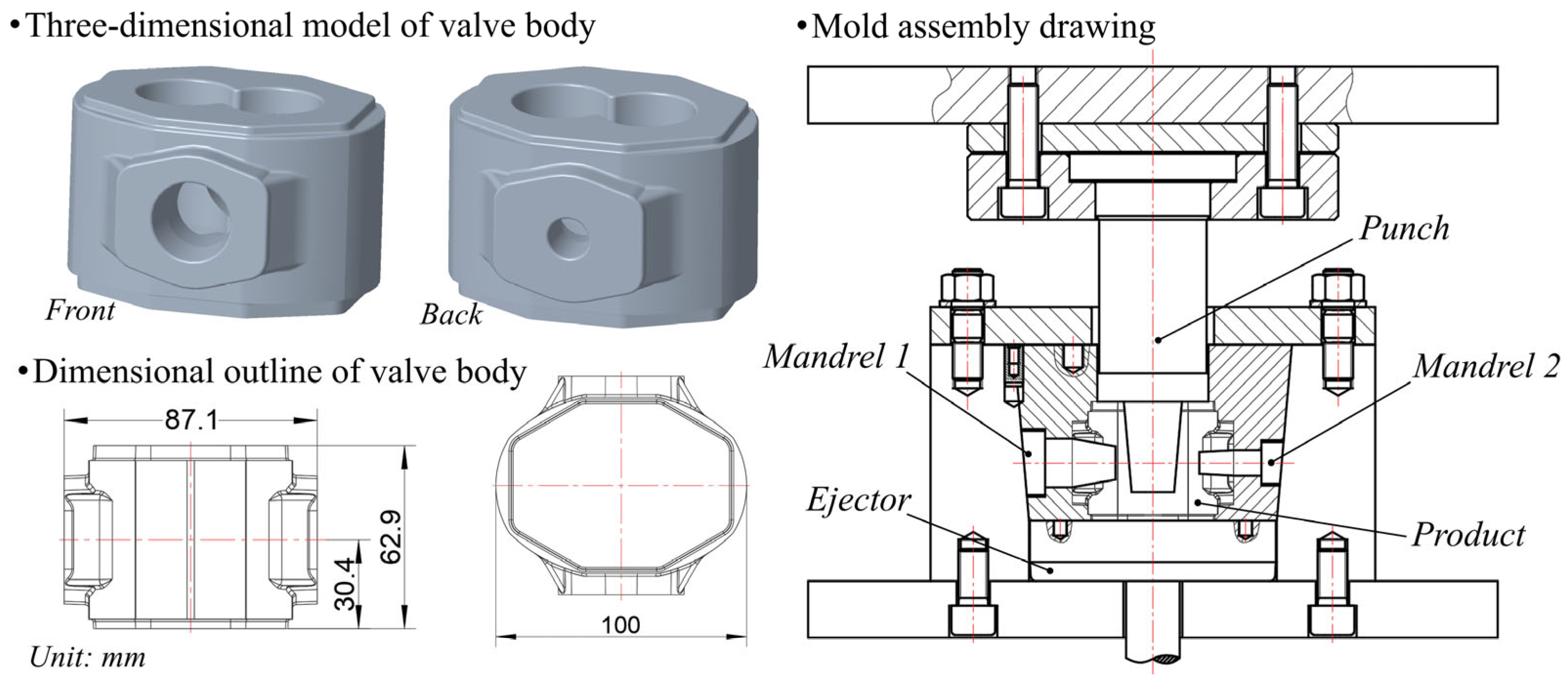

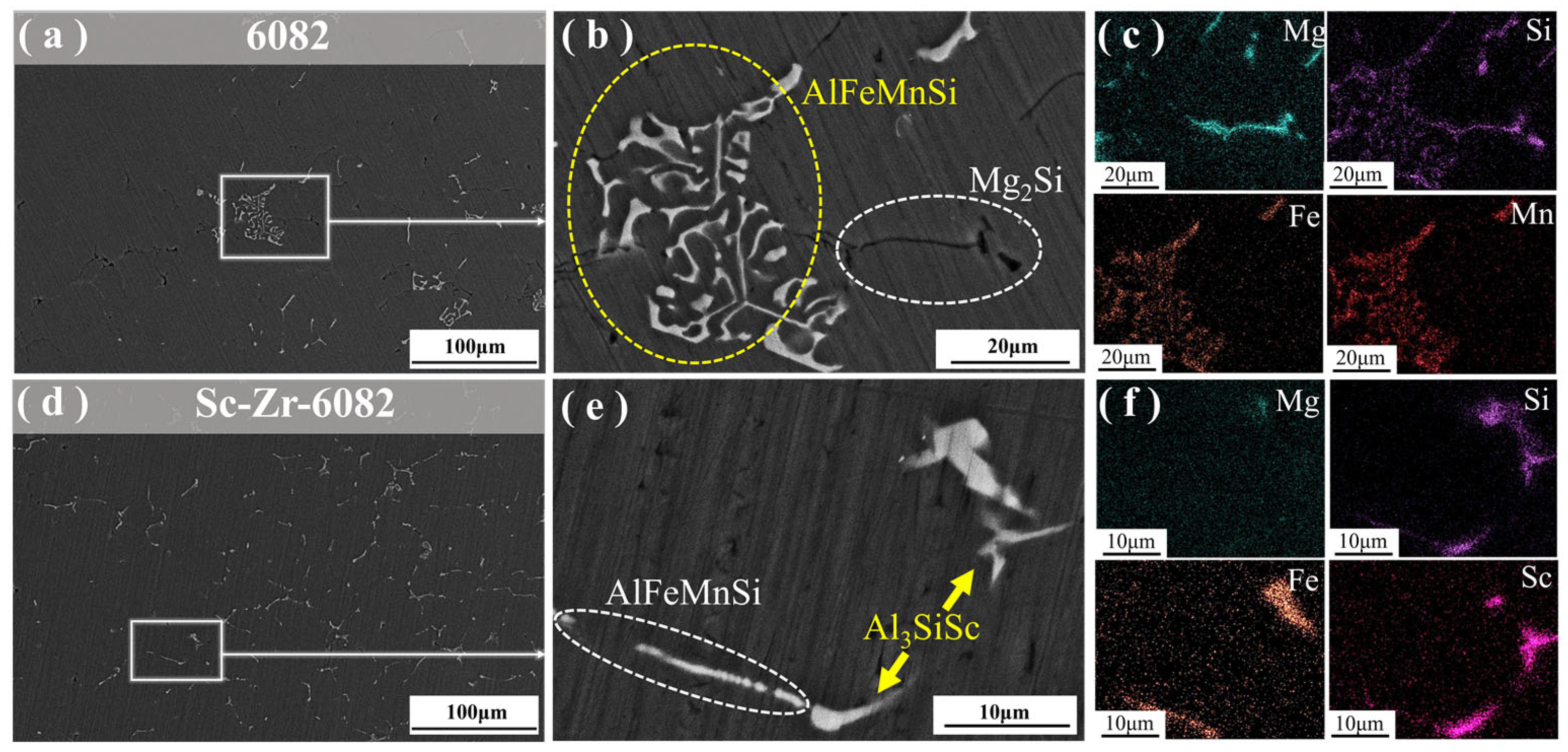
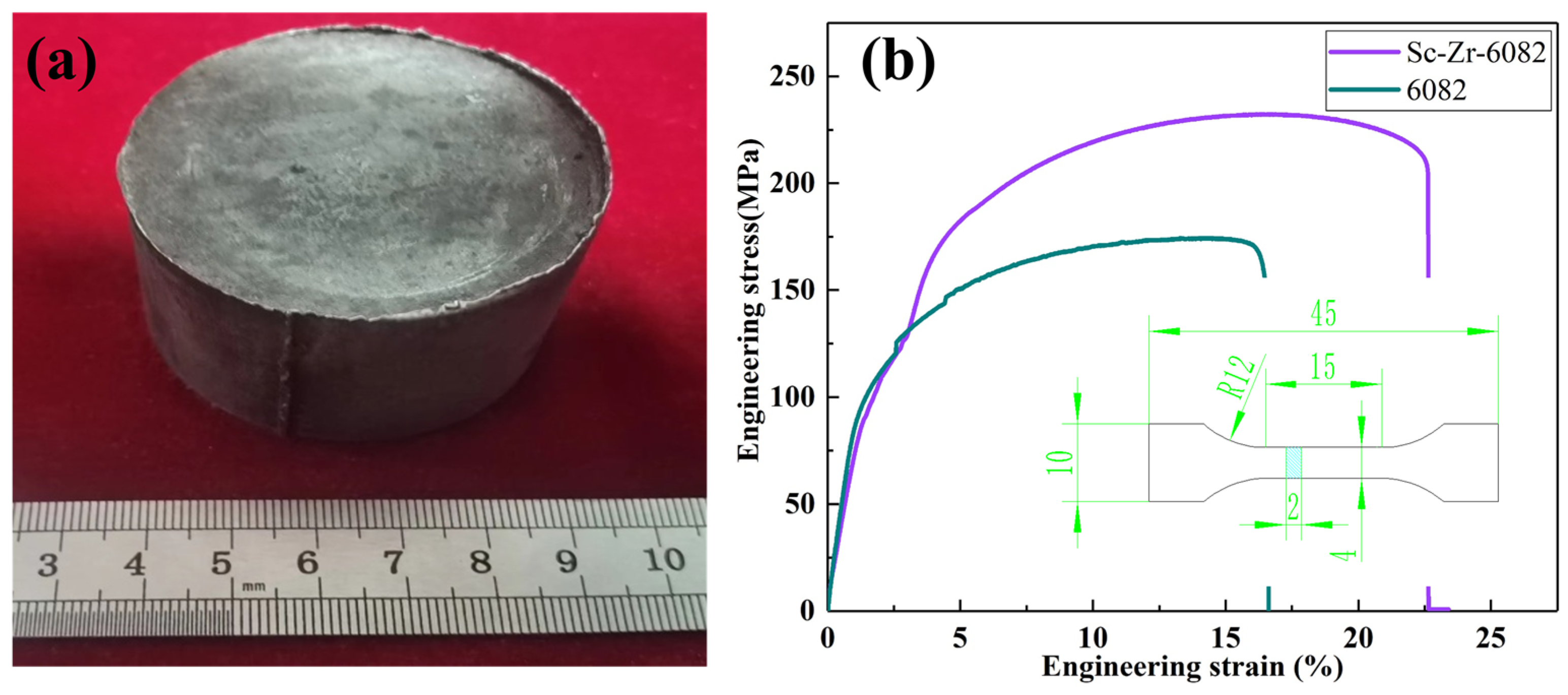
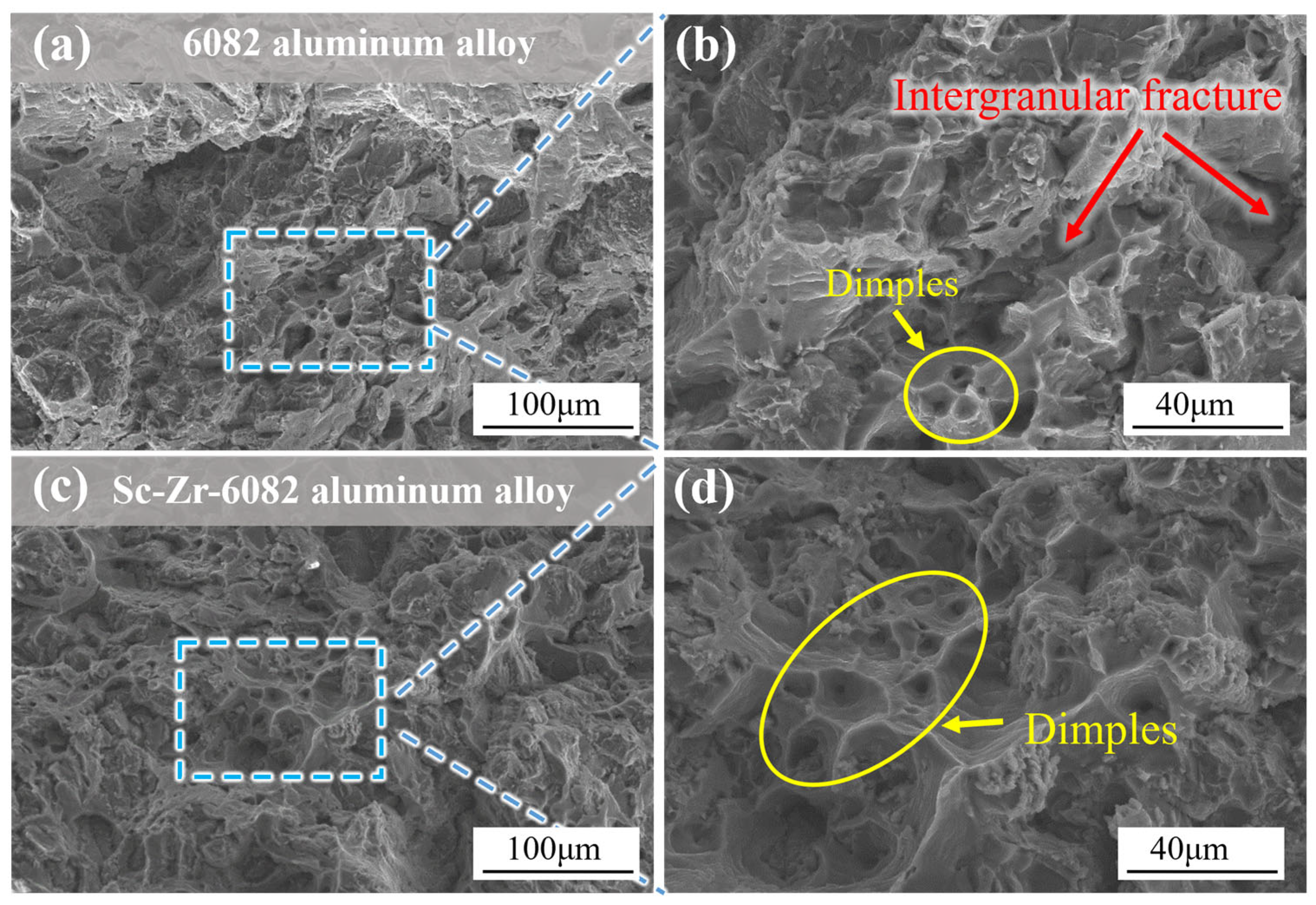
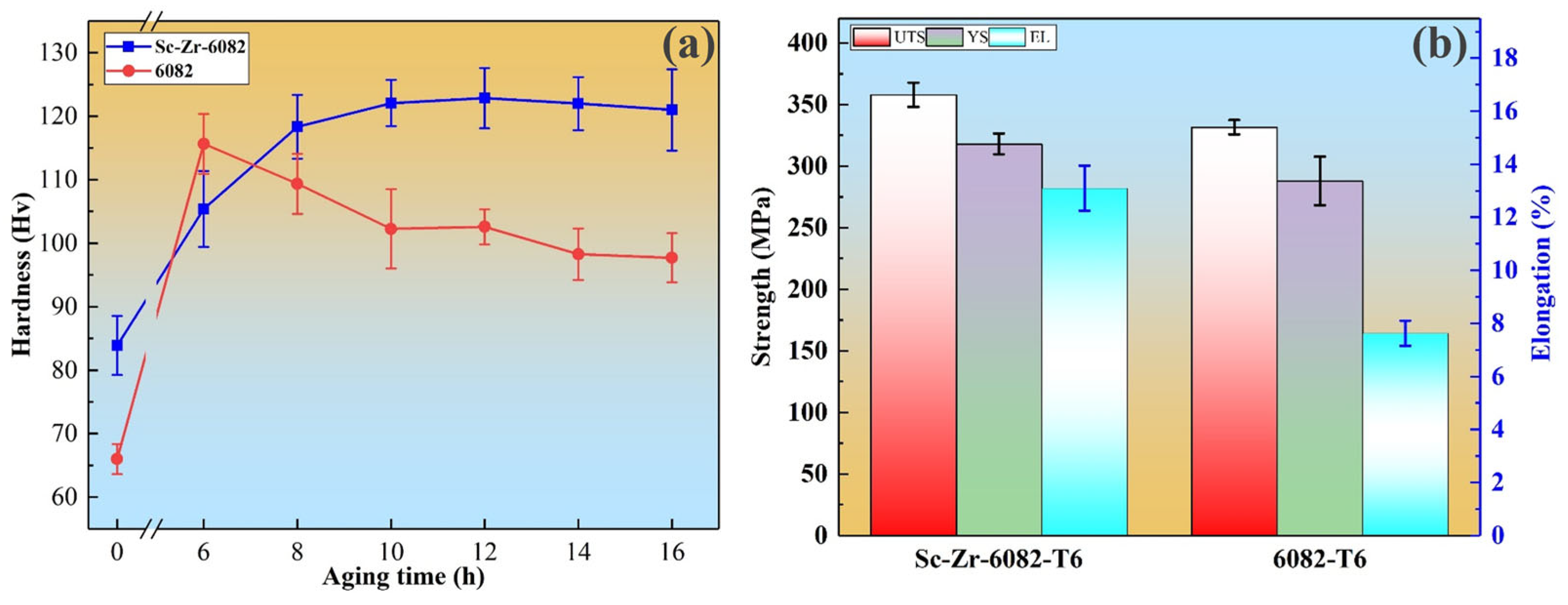




| Alloy | Mg | Si | Fe | Mn | Ti | Zn | Cr | Sc | Zr | Al |
|---|---|---|---|---|---|---|---|---|---|---|
| 6082 | 1.056 | 1.072 | 0.275 | 0.523 | 0.026 | 0.053 | 0.147 | - | - | Bal. |
| Sc-Zr-6082 | 1.002 | 1.008 | 0.222 | 0.506 | 0.030 | 0.047 | 0.154 | 0.298 | 0.196 | Bal. |
| Experimental Alloys | YS (MPa) | UTS (MPa) | EL (%) |
|---|---|---|---|
| 6082 | 93 ± 1 | 171 ± 3 | 19 ± 2 |
| Sc-Zr-6082 | 123 ± 5 | 239 ± 6 | 22 ± 1 |
| Locations | YS (MPa) | UTS (MPa) | EL (%) |
|---|---|---|---|
| A | 360 ± 6 | 372 ± 6 | 17 ± 1 |
| B | 329 ± 37 | 340 ± 20 | 12 ± 2 |
Disclaimer/Publisher’s Note: The statements, opinions and data contained in all publications are solely those of the individual author(s) and contributor(s) and not of MDPI and/or the editor(s). MDPI and/or the editor(s) disclaim responsibility for any injury to people or property resulting from any ideas, methods, instructions or products referred to in the content. |
© 2025 by the authors. Licensee MDPI, Basel, Switzerland. This article is an open access article distributed under the terms and conditions of the Creative Commons Attribution (CC BY) license (https://creativecommons.org/licenses/by/4.0/).
Share and Cite
Qi, Y.; Wei, F.; Wang, Y.; Jin, Y.; Chang, X.; Chen, G. Microstructure and Mechanical Property of 6082 Aluminum Alloy via Sc and Zr Addition Combined with Squeeze Casting. Materials 2025, 18, 1988. https://doi.org/10.3390/ma18091988
Qi Y, Wei F, Wang Y, Jin Y, Chang X, Chen G. Microstructure and Mechanical Property of 6082 Aluminum Alloy via Sc and Zr Addition Combined with Squeeze Casting. Materials. 2025; 18(9):1988. https://doi.org/10.3390/ma18091988
Chicago/Turabian StyleQi, Yushi, Fangming Wei, Yu Wang, Yu Jin, Xusheng Chang, and Gang Chen. 2025. "Microstructure and Mechanical Property of 6082 Aluminum Alloy via Sc and Zr Addition Combined with Squeeze Casting" Materials 18, no. 9: 1988. https://doi.org/10.3390/ma18091988
APA StyleQi, Y., Wei, F., Wang, Y., Jin, Y., Chang, X., & Chen, G. (2025). Microstructure and Mechanical Property of 6082 Aluminum Alloy via Sc and Zr Addition Combined with Squeeze Casting. Materials, 18(9), 1988. https://doi.org/10.3390/ma18091988






